The following is excerpted from my book Lakehurst: Barrens, Blimps and Barons.
Seventy-five years ago today, fire rained down from the sky when the great airship Hindenburg exploded into a ball of flame over Lakehurst on May 6, 1937, in the process leaving an unforgettable mark on history.
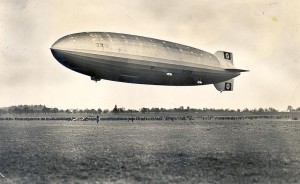 To this day, it remains the largest vessel ever to take to the skies. It was over 800 feet long; as long as two football fields and the majority of a third. Despite its stunning bulk, it routinely made the flight from Germany to Lakehurst, NJ in a mere two days while carrying scores of passengers.
To this day, it remains the largest vessel ever to take to the skies. It was over 800 feet long; as long as two football fields and the majority of a third. Despite its stunning bulk, it routinely made the flight from Germany to Lakehurst, NJ in a mere two days while carrying scores of passengers.
The Hindenburg was a Nazi vessel, constructed by the Germans in 1935 as the crowning jewel of its vast fleet of zeppelins. From the very start the vessel was destined to make history.
The craft was undeniably luxurious for its time. It featured a lounge and dining rooms, a smoking room (right next to thousands of cubic feet of highly flammable hydrogen) and a spectacular viewing room. Chefs prepared gourmet meals. Music played. It was, by all accounts, an elegant affair enjoyed by the rich and privileged. A round-trip ticket from Germany to America and back again on board the Hindenburg cost $720. Accounting for inflation, that’s over $10,000 in 2006 dollars.
While the story of the Hindenburg disaster has been well told, the vessel did not simply fly into town one day and explode into flame. During 1936 and 1937, the massive aircraft made no less than 10 trips to the small Pine Barrens borough. Over 1,000 passengers made the journey, and mail and freight, including full-sized automobiles, came with them.
And those trips drew attention. In the days before television and 24-hour news, a visit by the Hindenburg captured the attention of the entire town.
Like so many Lakehurst residents during the 1930s, memories of the Hindenburg remain fresh to Leo Whalen, probably better known to longtime residents as Pete Whalen. Whalen moved out of town in 1941 or so, when he was about 14, but his memories of the Hindenburg and its crew are still vivid. Interviewed in 2004 for Lakehurst: Barrens, Blimps & Barons, Whalen said people would congregate in the streets of town, their eyes turned skyward to watch it pass overhead.
“When that came over, everybody looked. I remember I saw it in the summer of 1936,” Whalen said. “I remember the German sailors coming over to my father’s store to buy soda and candy and souvenirs to bring back to Germany. I remember them being real sharp in their uniforms.”
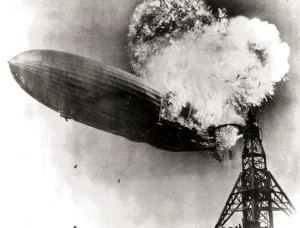 The Hindenburg’s dominance of the skies would not last very long.
The Hindenburg’s dominance of the skies would not last very long.
On May 3, 1937, the German craft took off from its airfield in Frankfurt and made a seemingly routine voyage across the Atlantic. It was the tenth time it had made the journey. About twenty or so trans-Atlantic trips were planned for the year, seventeen of them scheduled to go to Lakehurst, the others to South America.
John Iannaccone was among those who saw history unfold. Iannaccone, who passed away in 2005, began his career at Navy Lakehurst in 1929. He knew his airships; he served on the U.S.S. Los Angeles, bouncing back and forth between Lakehurst and the west coast. In May 1937, he had a better view of the Hindenburg than most, serving on the mooring mast crew tasked with helping land the ship.
Also on the ground was Herbert Morrison from a Chicago radio station. He was in Lakehurst to witness the majestic Hindenburg arrive. Morrison ended up making one of the most recognizable news broadcasts of the last 100 years, his words “oh, the humanity” becoming a cultural landmark.
A short mile or so away, watching from the quiet confines of the Borough of Lakehurst, were scores of town residents, gathered in the streets and on roofs and just outside their favorite watering hole. Among them was Whalen. That massive vessel was once against coasting triumphantly into town. And then something happened.
“I was looking at it with my cousin with binoculars,” Whalen recalled. “And then we could see the explosion.”
The Hindenburg, the largest aircraft ever to take flight, was on fire.
It was overcast when the craft sailed in, raining intermittently, but the weather was manageable and improving. At this point, the trip was probably routine for crew members both in the craft and on the ground, so the weather wasn’t a great concern.
Below, a throng of spectators were gathered on the field behind Hangar No. 1. On the ground watching along with the others was Morrison, covering the event for radio. As Morrison watched the Hindenburg cruise into town, all seemed well. For a brief moment he mentioned the start of rain – and then in mid thought the broadcast changed.
“It’s starting to rain again; the rain had slacked up a little bit. The back motors of the ship are just holding it, just enough to keep it from —
“It burst into flames! Get out of the way! Get out of the way!” Morrison wailed.
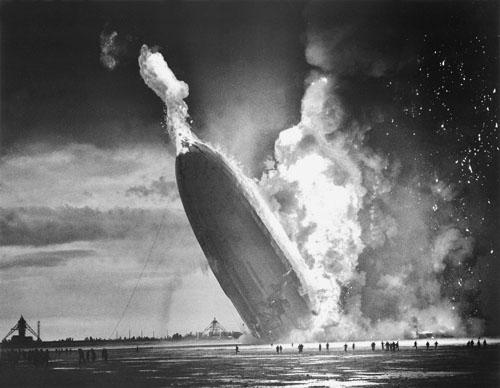 Morrison, a longtime broadcaster and a true professional, was completely caught up in the moment, giving his emotional response to the disaster as it happened. His radio recording now serves as a landmark in broadcasting history.
Morrison, a longtime broadcaster and a true professional, was completely caught up in the moment, giving his emotional response to the disaster as it happened. His radio recording now serves as a landmark in broadcasting history.
The smoldering remains of the massive craft were raining down upon the dozens below. Burning cinders and framework, and even people, trying in futility to leap to safety. But even as the airship fell, Iannaccone did not turn and run. He sprang into action.
“As most people at the scene were running from underneath the enormous airship as it began its fiery 30-second decent into history, Iannaccone observed what was happening from the mooring mast and began rescuing survivors,” Thomas Worsdale, former Public Affairs Officer at the Navy base, wrote in 2002 about Iannaccone’s efforts.
And then it was finished. As big as the event looms in aviation history, it was over in a matter of moments. Flamed out, and died.
“By the time it hit the ground, it was out,” Iannaccone said. “It burned that quick.”
In just 37 seconds, the Hindenburg was lost. With it went 36 victims.


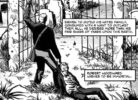

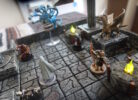


Pingback: The Ghosts of Lakehurst Hangar No. 1: A real life ghost story – ERIC SAN JUAN
Pingback: TODAY IN HISTORY: Graf Zeppelin completes first Transatlantic flight, lands in Lakehurst – ERIC SAN JUAN
Pingback: My Lakehurst book is here, so that’s pretty cool – ERIC SAN JUAN
Pingback: Thinking about doing some self-publishing, part 1 – ERIC SAN JUAN
Pingback: Grappling with the business of writing – ERIC SAN JUAN